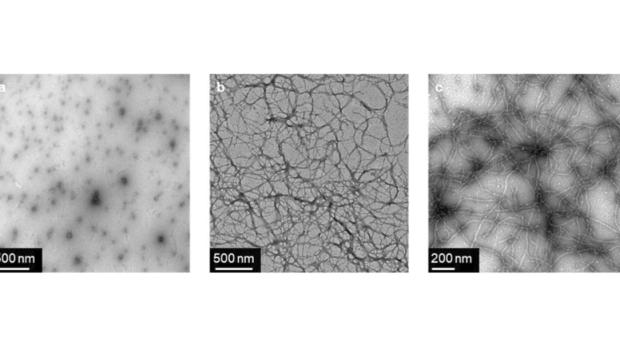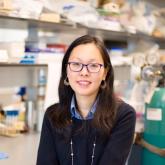“On/off” switches for self-assembling hydrogels could advance wound healing, osteoarthritis treatments and more

Gelation of self-assembling fibrous hydrogel comprising a coiled-coil protein (Q) at pH 6, 7.4 and 10 (Credit: Jin Kim Montclare)
BROOKLYN, New York, Wednesday, June 23, 2021 — Owing to their tunable properties, hydrogels comprising stimuli-sensitive polymers are among the most appealing molecular scaffolds because their versatility allows for applications in tissue engineering, drug delivery and other biomedical fields.
Peptides and proteins are increasingly popular as building blocks because they can be stimulated to self-assemble into nanostructures such as nanoparticles or nanofibers, which enables gelation — the formation of supramolecular hydrogels that can trap water and small molecules. Engineers, to generate such smart biomaterials, are developing systems that can respond to a multitude of stimuli including heat. Although thermosensitive hydrogels are among widely studied and well-understood class of protein biomaterials, substantial progress is also reportedly being made in incorporating stimuli-responsiveness including pH, light, ionic strength, redox, as well as the addition of small molecules.
A team of researchers at the NYU Tandon School of Engineering, who previously reported a responsive hydrogel formed using a coiled-coil protein, Q, expanded their studies to identify the gelation of Q protein at distinct temperatures and pH conditions. The study, “Self-assembly of stimuli-responsive coiled-coil fibrous hydrogels,” appears in the Royal Society of Chemistry journal Soft Matter.
Jin Kim Montclare, professor of chemical and biomolecular engineering, with affilations at NYU Langone Health and NYU College of Dentistry, directed this research with first author Michael Meleties, fellow Ph.D. student Dustin Britton, postdoctoral associate Priya Katyal, and undergraduate research assistant Bonnie Lin.
Using transmission electron microscopy, rheology and structural analyses, they observed that Q self-assembles and forms fiber-based hydrogels exhibiting upper critical solution temperature (UCST) behavior with increased elastic properties at pH 7.4 and pH 10. At pH 6, however, Q forms polydisperse nanoparticles, which do not further self-assemble and undergo gelation. The high net positive charge of Q at pH 6 creates significant electrostatic repulsion, preventing its gelation. This study will potentially guide the development of novel scaffolds and functional biomaterials that are sensitive towards biologically relevant stimuli.
Montclare explained that upper critical solution temperature (UCST) phase behavior is characterized by a solution that will form a hydrogel when it is cooled below a critical temperature.
"In our case, it is due to the physical crosslinking/entanglement of fibers that our fiber-based hydrogel forms when cooled," she said, adding that when the temperature is raised above the critical temperature, the hydrogel transitions back into solution and most of the fibers should disentangle.
"In our study, we looked at how this process is affected by pH. We believe that the high net charge of the protein at pH 6 creates electrostatic repulsions that prevent the protein from assembling into fibers and further into hydrogels, while at higher pH where there would be less electrostatic repulsion, the protein is able to assemble into fibers that can then undergo gelation."
The study, "Self-assembly of stimuli-responsive coiled-coil fibrous hydrogels," can be found online at the Royal Society of Chemistry.
The research was supported by the National Science Foundation.
About the New York University Tandon School of Engineering
The NYU Tandon School of Engineering dates to 1854, the founding date for both the New York University School of Civil Engineering and Architecture and the Brooklyn Collegiate and Polytechnic Institute. A January 2014 merger created a comprehensive school of education and research in engineering and applied sciences as part of a global university, with close connections to engineering programs at NYU Abu Dhabi and NYU Shanghai. NYU Tandon is rooted in a vibrant tradition of entrepreneurship, intellectual curiosity, and innovative solutions to humanity’s most pressing global challenges. Research at Tandon focuses on vital intersections between communications/IT, cybersecurity, and data science/AI/robotics systems and tools and critical areas of society that they influence, including emerging media, health, sustainability, and urban living. We believe diversity is integral to excellence, and are creating a vibrant, inclusive, and equitable environment for all of our students, faculty and staff. For more information, visit engineering.nyu.edu.



